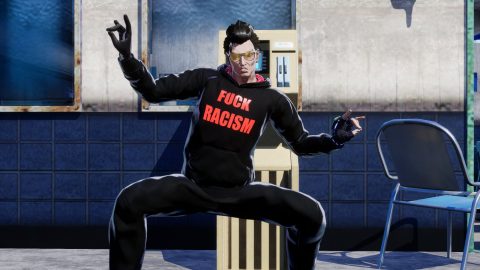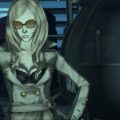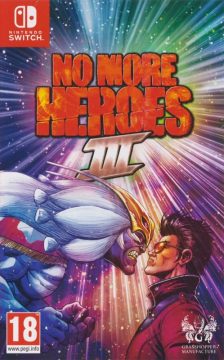
What do you do after releasing something like Travis Strikes Again? What do you do after laying out your soul like that, expressing your love and excite for a medium, despite so many complications in your own experience? Turns out the answer was have some fun. Once again, Suda, returning co-director Ren Yamazaki, and Grasshopper Manufacture have decided to do something completely different, shifting yet again into an over the top superhero story and slight satire, and also expanding on familiar formulas and gameplay to make something that managed to stick out from the crowd. No More Heroes III was absolutely not what anyone expected, and that is arguably its greatest strength.
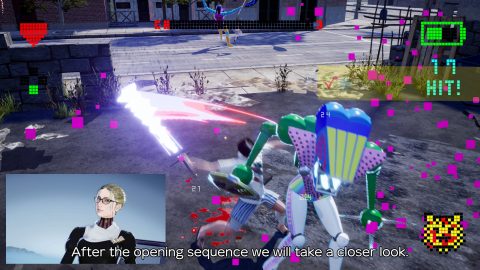
Some time has passed since Travis Strikes Again, Travis and Bad Man having successfully resurrected Bad Girl with the Death Drive, now bumming it in Travis’ Santa Destroy apartment with Shinobu in tow. Sylvia, on the other hand, is busy working as the secretary for Damon Ricotello (not to be confused for the architect behind the Unity runtime disaster), the man who ran Juvenile out of the gaming industry. He’s a real estate mogul now, among many other things, and is waiting for his old fluff-ball alien friend from childhood named FU to arrive, having promised to return after twenty years had passed.
This turns out to be a less than happy reunion, as FU has grown a lot, becoming a galactic prince, and is on Earth with his friends from an intergalactic prison to take over. He proclaims himself a “goddamn superhero” and starts an invasion, and Travis quickly takes up the challenge, with help from Sylvia organizing the conflict into the UAA’s rank assassin battle system. The fate of the world is now in the hands of an otaku turned deadbeat dad, but at least said otaku turned deadbeat dad has a powerful henshin suit.
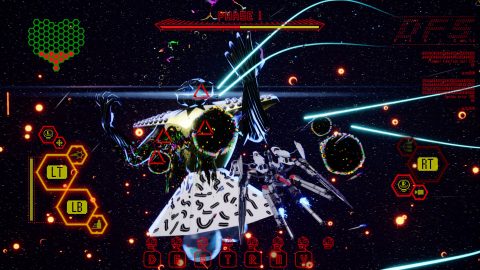
No More Heroes III‘s narrative does have a tad more going on between the lines then it initially seems, but far less than the original game or TSA. The majority of it is very surface level, like the extremely cheesy power of friendship and examination of toxic relationships that define the dynamics Travis has with his friends, contrasted with FU’s imbalanced friendships. The game even has multiple Rocky 3 montage send-ups, complete with similar music, showing the gang being buds.
However, there’s still a very welcome undercurrent of Travis grappling with his past as a mad killer, and the twisted relationship between FU and Damon remains impactful and effective the whole way, humanizing both of them to make them tragic in their monstrous behavior. All in all, the game is just a celebration of the series and the team’s many nerdy interests, from tokusatsu to modern Hollywood blockbusters, with an edge of meta commentary mixed in on Travis stuck in an endless cycle as an action game protagonist (mainly via Sylvia’s strange dialog after some ranking fights).
The one area the game suffers with writing wise is a pretty common one with Suda pinned stories. He has trouble explaining concepts in his stories, which often works due to the heavy layer of abstraction, but this entry is more straightforward than usual. The team also apparently lacked the time to include a scene towards the end of the game meant to explain that FU and friends were more demons than aliens, where Travis would arrive at the prison they left and meet a major antagonist from Shadows of the Damned. FU and friends being demons is still a part of the story, hints at more than a few parts, and Travis directly mentioning the prison as if he visited it in the final confrontation. Still, that scene’s absence does leave things feeling a tad confusing in the later half as a major story beat is missing.
The general structure of the first two No More Heroes games returns. Travis has to pay a fee to get to each battle, requiring bonus missions, chores, and various other activities to do, scattered on a world map (ordered into five zones). Currency is now divided into Utopicoins, the currency used at a theme park called Utopiland that Damon has built, and WESN, an alien currency used mostly for upgrades. Activities tend to give a bit of both, and there’s tons to find, mainly for completionist bloat. The wave battle defense missions, in particular, are extremely numerous in the late game. It does not take long to max out your upgrades.
The end of episode levels have now been replaced with designated battles, scattered on the map. A select few must be finished in order to unlock the option to pay the ranked fight fee, usually throwing a collection of diverse aliens at you to deal with. This is where the depth of this entry’s battle system comes from, as the switch over to aliens means a much greater variety of enemy types you have to learn, instead of the mostly interchangeable goons from the Wii era.
While the humanoid lance users are easy enough to fight as previous enemies were, it does not take long for the diversity of the enemy line-up to complicate fights. There’s jumpy lizard guys that can’t be easily combo’ed, but can be grappled from behind if you get back there after dodging an attack. Some tanky floaters take out shields after some frontal bashing, and can shoot sticky bombs if you’re not paying close attention. There’s bikers who charge at you with katanas, with fast and hard hitting attacks that you can see coming with a still period and dodge to counter. The list goes on and on.
Travis has a ton of new options to compensate. Grappling has been properly mixed into Travis’ basic moveset, able to suplex or such anyone once he grabs them from directly behind, while grappling when they’re stunned results in a way stronger version that recovers beam katana battery. He’s gained a Bayonetta style slow-mo on a good dodge, offering a huge opportunity for a free combo if you can nail the timing of enemy attacks. Travis also brings over chips from TSA, starting with a teleporting kick that can be used for bridging gaps and punishing enemies. Once you reach the rank eight fight, you get the rest of the set, including an AOE chip damage rain, a smaller AOE enemy slow-down, and a telekinesis grab you have control over the direction of.
All this makes for one of the most visceral and complex of the No More Heroes battle systems. There’s still a lot of mashing due to the high health bars of later game enemy variants, but the moves you make to open up an enemy for an offensive push are far more important, especially with crowd control. Travis’ death drive chips also help as a crutch for newer players, particularly the powerful default Death Kick, which does an easy bunch of damage on whatever you lock onto. Yet, it’s not an instant win button, as later enemy types are able to punish abusing these powers, helped by them being on cooldowns.
There’s also tension, a reflection of your momentum in battle, going up via good performance and giving you bonus damage, and going down with poor performance. Finishing enemies brings back the slot system from previous games, giving a random power-up, this time mostly just extra currency, energy refill, and four power up modes. Mustang mode makes Travis go at insane speeds with his katana for huge combos, and throw-crazy puts your hands on fire and lets you do big grapples from any position constantly. Travis’ superhero transformation comes into play with Full Armor mode, which lets you fire off a bunch of missiles for huge damage, and the green variant you control, with an additional charge super move. While the lack of the original’s swarm of super modes is a bit disappointing, each mode has a clear use that fits into gameplay well, and green mode is a way more satisfying form than the janky tiger form from NMH2.
We also have the addition of space combat, where Travis uses a more powerful form of his armor mode and gets into a fight with a huge enemy in space. They’re a fun little addition, offering a small selection of these enemies to deal with, and definitely add a good bit of spectacle via the energy beam ability you have to aim on a weak spot for huge damage. They do start wearing out their welcome, though, due to them being lumped with defense missions, with less variety.
All that said, the game struggles with its additional systems. Going for full completion isn’t at all enticing, since it doesn’t take long to fully deck out Travis, even with the chip system. The idea is to allow you to mod Travis’ stats and abilities with passives and unique bonuses, from more slow-mo dodge time to increased tension. In practice, it does not take long to get two or three really good chips, crafted with random nonsense from doing chores and missions, and then you’ll have no desire to get anything else at all. As for collecting the various doodads in the overworlds, your reward is just shirts, which are cool, but a far cry from the extra moves or weapons previous entries offered.
What the team did nail was the overall style. This feels like a natural evolution from the thick shadows of the first game and the more colorful look of the second game. There’s even a cool streaming motif to fit the theme of superheroes, complete with an Ultraman style intro every “episode” and a classic anime style close out credit roll after every ranked fight. All the bosses and enemies have really fun designs, due in part to a whole swath of guest star character designers, including a Borderlands artist and the designer of Bayonetta. The mix of Santa Destroy’s old craphole desert America outskirts urban design and Damon’s gentrified areas mixed in give the game a really unique place in the series as well.
The soundtrack is also extremely interesting, due to the inclusion of Nobuaki Kaneko, drummer for the band Rize (who Like A Dragon fans may remember for their baffling theme Muppet for the PSP spinoffs). He ended up making a new band called Red Orca during the game’s development, the first track they put out having an alternate version being used as a boss theme in the game proper. His work is heavy on pushing a particular vibe with repeating beats, and it often works very well. Kazuhiro Abo also returns from TSA, and a variety of guest composers also helped flesh things out. The two stand outs of these are Gold Joe’s theme by Abo and Tony Astro, specifically inspired by a lot of trance and electronic music popular in the gay club scene. It has a really unique and smooth rhythm to it. Astro went into greater detail on his inspirations in the Gold Joe section of this video essay here. Abo also notably collabed with Okumura to make the incredible sushi shop theme. The flow these guys brought to what amounts to an ad jingle is absurd, and very much appreciated.
While No More Heroes III has its issues and some missed opportunities, that’s what is to be expected from Grasshopper by this point (not helped by the Pandemic affecting development). Also expected is the powerful energy that comes from creatives working together to make something strange and unique, here in full force, and the very human feeling writing of Suda, despite the very abnormal subject matter. Even if this is far from his more emotional or complex work, what Suda and the rest of the team managed here is refreshing, even while trying to grapple with modern gaming trends. Some worked, some didn’t, but the overall result is a joyful experience that makes you feel happy to be alive if you’re willing to embrace the sheer cheese of what is being thrown down. This could be the last game in the series, with Grasshopper looking to make a series they have full control over (Marvelous owns the IP), and if so, it’s a pretty satisfying note to go out on.

